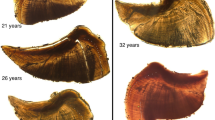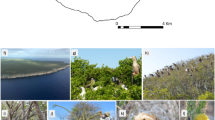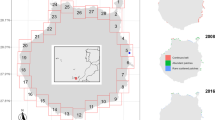Abstract
Analysis of synchrony in population fluctuations is a central topic in ecology. It can help identify factors that regulate populations, and also the scales at which these factors exert their influence. Using long-term data from seven Brünnich’s guillemot colonies in Svalbard, Norway, we determined that year to year population fluctuations were synchronized in six of the seven colonies. The seventh colony was located farther away and in a different oceanographic system. Moreover, all seven colonies have declined significantly since the late 1990s following a very similar pattern. If the rate of population decline does not change, Brünnich’s guillemots in Svalbard have a high probability of becoming quasi-extinct within the next 50 years. The high synchrony between the different colonies could further increase this risk of extinction. Our results indicate that environmental forcing plays a role in the colony size fluctuation of Brünnich’s guillemot (i.e., a Moran effect). These fluctuations are well explained by changes in the subpolar gyre in the region where Brünnich’s guillemots overwinter. This subpolar gyre weakened in the mid-1990s, leading to a warming of the North Atlantic. Our study indicates that this basin-scale shift in the subpolar gyre is closely related to the decline in Brünnich’s guillemot in Svalbard. Our results suggest that the causal mechanism linking changes in oceanographic conditions in the North Atlantic and Brünnich’s guillemot population dynamics are likely mediated, at least partly, by changes in recruitment.






Similar content being viewed by others
References
Bjørnstad ON, Ims RA, Lambin X (1999) Spatial population dynamics: analyzing patterns and processes of population synchrony. Trends Ecol Evol 14:427–432
Bolker BM et al (2009) Generalized linear mixed models: a practical guide for ecology and evolution. Trends Ecol Evol 24:127–135
Caswell H (2000) Prospective and retrospective perturbation analyses: their roles in conservation biology. Ecology 81:619–627
Descamps S et al (2010) Detecting population heterogeneity in effects of North Atlantic Oscillations on seabird body condition: get into the rhythm. Oikos 119:1526–1536
deYoung B et al (2008) Regime shifts in marine ecosystems: detection, prediction and management. Trends Ecol Evol 23:402–409
Earn DJD, Levin SA, Rohani P (2000) Coherence and conservation. Science 290:1360–1364
Engen S, Lande R, Saether BE, Bregnballe T (2005) Estimating the pattern of synchrony in fluctuating populations. J Anim Ecol 74:601–611
Fort J et al (2013) Energetic consequences of contrasting winter migratory strategies in a sympatric Arctic seabird duet. J Avian Biol 44:001–008
Frederiksen M, Harris MP, Daunt F, Rothery P, Wanless S (2004) Scale-dependent climate signals drive breeding phenology of three seabird species. Glob Change Biol 10:1214–1221
Fuglei E, Oritsland NA, Prestrud P (2003) Local variation in arctic fox abundance on Svalbard, Norway. Polar Biol 26:93–98
Gaillard J-M, Festa-Bianchet M, Yoccoz NG, Loison A, Toïgo C (2000) Temporal variation in fitness components and population dynamics of large herbivores. Ann Rev Ecol Syst 31:367–393
Gaston AJ (2003) Synchronous fluctuations of thick-billed murre (Uria lomvia) colonies in the eastern Canadian arctic suggest population regulation in winter. Auk 120:362–370
Gaston AJ, Deforest LN, Donaldson G, Noble DG (1994) Population parameters of thick-billed Murres at Coats Island, Northwest-Territories, Canada. Condor 96:935–948
Gremillet D, Charmantier A (2010) Shifts in phenotypic plasticity constrain the value of seabirds as ecological indicators of marine ecosystems. Ecol Appl 20:1498–1503
Grenfell BT et al (1998) Noise and determinism in synchronized sheep dynamics. Nature 394:674–677
Hatun H, Sando AB, Drange H, Hansen B, Valdimarsson H (2005) Influence of the Atlantic subpolar gyre on the thermohaline circulation. Science 309:1841–1844
Hatun H et al (2009) Large bio-geographical shifts in the north-eastern Atlantic Ocean: from the subpolar gyre, via plankton, to blue whiting and pilot whales. Prog Oceanogr 80:149–162
Heino M, Kaitala V, Ranta E, Lindstrom J (1997) Synchronous dynamics and rates of extinction in spatially structured populations. Proceedings of the Royal Society of London Series B-Biological Sciences 264:481–486
Hurrell JW, Dickson RR (2004) Climate variability over the North Atlantic. In: Stenseth NC, Ottersen G, Hurrell JW, Belgrano A (eds) Marine ecosystems and climate variation. Oxford University Press, Oxford, pp 15–31
Hurrell JW, Kushnir Y, Visbeck M (2001) The North Atlantic Oscillation. Science 291:603–605
Ims RA, Steen H (1990) Geographical synchrony in microtine population-cycles—A theoretical evaluation of the role of nomadic avian predators. Oikos 57:381–387
Irons DB et al (2008) Fluctuations in circumpolar seabird populations linked to climate oscillations. Glob Change Biol 14:1455–1463
Jenouvrier S, Barbraud C, Cazelles B, Weimerskirch H (2005) Modelling population dynamics of seabirds: importance of the effects of climate fluctuations on breeding proportions. Oikos 108:511–522
Johnson DM, Liebhold AM, Bjornstad ON, McManus ML (2005) Circumpolar variation in periodicity and synchrony among gypsy moth populations. J Anim Ecol 74:882–892
Kosmelj K, Blejec A, Cedilnik A (2005) Interval estimate for specific points in polynomial regression. J Comput Informat Theory 4:287–291
Kålås JA et al. (2010) Norwegian Red List for Species
Lande R, Engen S, Sæther B-E (2003) Stochastic population dynamics in ecology and conservation. Oxford University press, Oxford
Liebhold A, Koenig WD, Bjornstad ON (2004) Spatial synchrony in population dynamics. Annu Rev Ecol Evol Syst 35:467–490
Loeng H (1991) Features of the physical oceanographic conditions of the Barents Sea. Polar Res 10:5–18
Lohmann K, Drange H, Bentsen M (2009) A possible mechanism for the strong weakening of the North Atlantic subpolar gyre in the mid-1990s. Geophys Res Lett 36:L15602
Moran PAP (1953) The statistical analysis of the Canadian lynx cycle. II. Synchronization and meteorology. Aust J Zool 1:291–298
Nussey DH, Wilson AJ, Brommer JE (2007) The evolutionary ecology of individual phenotypic plasticity in wild populations. J Evol Biol 20:831–844
Palmqvist E, Lundberg P (1998) Population extinctions in correlated environments. Oikos 83:359–367
Paradis E, Baillie SR, Sutherland WJ, Gregory RD (2000) Spatial synchrony in populations of birds: effects of habitat, population trend, and spatial scale. Ecology 81:2112–2125
Post E, Forchhammer MC (2002) Synchronization of animal population dynamics by large-scale climate. Nature 420:168–171
R Foundation for Statistical Computing. R Development Core Team (2010) R: a language and environment for statistical computing (http://www.R-project.org), Vienna, Austria
Ranta E, Kaitala V, Lundberg P (1998) Population variability in space and time: the dynamics of synchronous population fluctuations. Oikos 83:376–382
Sæther B-E, Bakke Ø (2000) Avian life history variation and contribution of demographic traits to the population growth rate. Ecology 81:642–653
Sandvik H, Erikstad KE, Barrett RT, Yoccoz NG (2005) The effect of climate on adult survival in five species of North Atlantic seabirds. J Anim Ecol 74:817–831
Steen H, Lorentzen E, Strøm H (2013) Winter distribution of guillemots (Uria spp.) in the Barents Sea. Norwegian Polar Institute Report Series, 141
Steiner UK, Gaston AJ (2005) Reproductive consequences of natal dispersal in a highly philopatric seabird. Behav Ecol 16:634–639
Strøm H (2006a) Brünnich’s guillemot. In: Kovacs KM, Lydersen C (eds) Birds and mammals of svalbard. Norwegian Polar Institute, Tromsø
Strøm H (2006b) Glaucous gull. In: Kovacs KM, Lydersen C (eds) Birds and mammals of svalbard. Norwegian Polar Institute, Tromsø
Svendsen H et al (2002) The physical environment of Kongsfjorden-Krossfjorden, an Arctic fjord system in Svalbard. Polar Res 21:133–166
Toms JD, Lesperance ML (2003) Piecewise regression: a tool for identifying ecological thresholds. Ecology 84:2034–2041
Votier SC et al (2005) Oil pollution and climate have wide-scale impacts on seabird demographics. Ecol Lett 8:1157–1164
Walsh PM, Halley DJ, Harris MP, del Nevo A, Sim IMW, Tasker ML (1995) Seabird monitoring handbook for Britain and Ireland: a compilation of methods for survey and monitoring of breeding seabirds. Joint Nature Conservation Committee, Royal Society of the Protection of Birds, Institute of terrestrial Ecology, Seabird Group, Peterborough
Acknowledgments
This study was funded by programs MOSJ (http://mosj.npolar.no/) and SEAPOP (http://seapop.no/). We are indebted to Fridtjof Mehlum and Vidar Bakken, who established the monitoring program in Svalbard, to all summer field assistants who participated to the study and counted Brünnich’s guillemots in Svalbard since 1988, to Anders Skoglund for making maps and to Kjell-Einar Erikstad, Christopher Johnson and two anonymous referees for very useful comments on a first version. Thanks to Peter and Marie Fast for English editing and to Helge Drange for providing and explaining the subpolar gyre data.
Author information
Authors and Affiliations
Corresponding author
Additional information
Communicated by Christopher Johnson.
Electronic supplementary material
Below is the link to the electronic supplementary material.
Rights and permissions
About this article
Cite this article
Descamps, S., Strøm, H. & Steen, H. Decline of an arctic top predator: synchrony in colony size fluctuations, risk of extinction and the subpolar gyre. Oecologia 173, 1271–1282 (2013). https://doi.org/10.1007/s00442-013-2701-0
Received:
Accepted:
Published:
Issue Date:
DOI: https://doi.org/10.1007/s00442-013-2701-0




